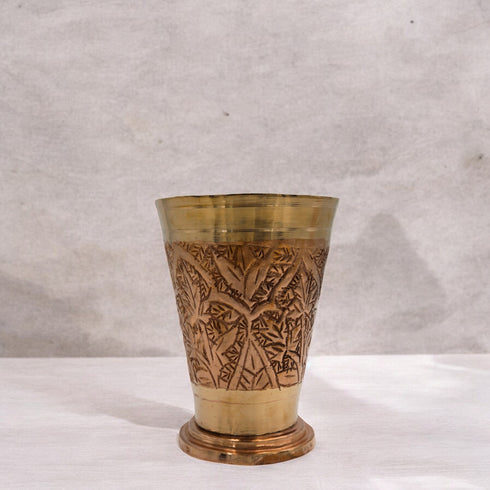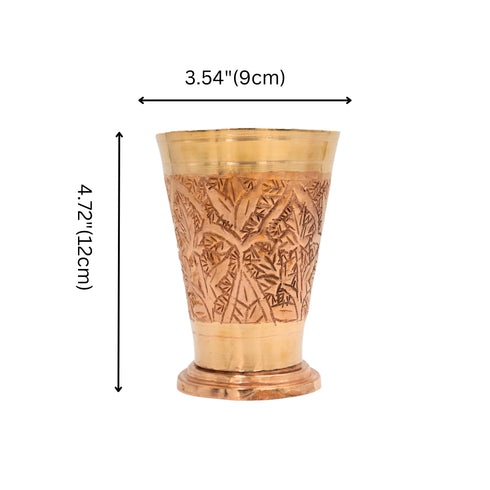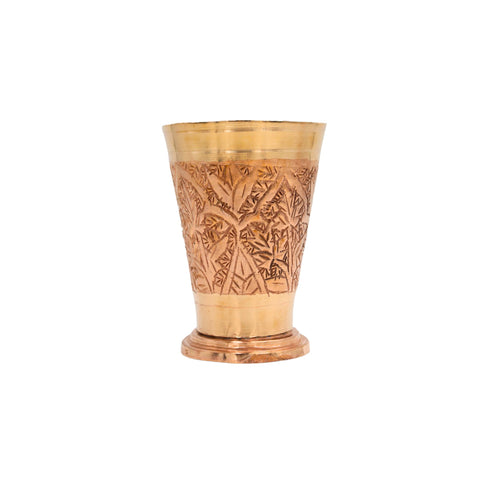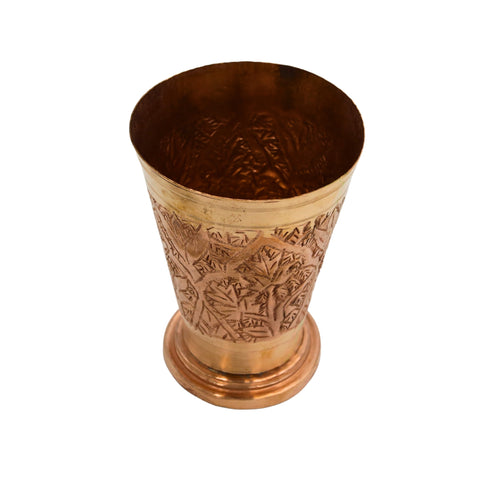Out of Stock
Kashmiri Copper Glass
₹1,209
₹839
Save 31%
Reignite tradition with our Pure Copper Glasses, showcasing luxury and heritage with their elegant bronze colour and intricate designs. Expertly crafted in Kashmir, they offer a touch of grandeur and a taste of the region’s rich cultural legacy.
Buying for a group or event?
Make a bulk enquiry

 Product Details
Product Details
- SKU Code: KW_CP_00419_CP
- Art Type : Copper Art
- Product : Copperware
- Material : Copper
- Raw Material used : Copper
- Dimensions : Length-9cms, Width-9cms, Height-12cms
- Design : Engraved Leaf Design
- Color : Copper
- Copper Weight: 170 gms
- Category : Decor
- Sub-category : Kitchen Decor
- Packaging Content : Copper Glass X 1
- Country of Origin : India
 Features
Features
- Authentic Craftsmanship Traditionally handcrafted by skilled artisans reflecting authentic Kashmiri craftsmanship and cultural heritage
- Material Typically made from high-quality solid copper which provides excellent heat conductivity and durability These materials are favoured for their ability to maintain consistent temperatures
- Natural Patina (Thin Layer) Without any coating our copper products develop a natural patina over time which can enhance its aesthetic appeal and provide a unique vintage look
- Cultural Significance Represents traditional Kashmiri practices and is often used in serving cuisine adding a touch of cultural authenticity
- Aesthetic Appeal The natural finish and traditional design can add a rustic charm and elegance to your kitchen or dining setting
 Preserving Cultural Tradition (Kandkari)
Preserving Cultural Tradition (Kandkari)
Kashmir is famous around the globe for its beyond belief craftsmanship and the greatest roots of art and culture. From the lining of the carpets to the threads of the pashminas to the shimmer of the copperware. Kashmir has given us art in its purest and the most refined form.
The history of copperware (known as kandkari Work) dates back to the 8th century when Saint and an Islamic scholar, Mir Syed Ali Hamdani (RA), who traveled from Central Asia came all the way to India. He turned out not just a well-versed scholar but also an affable lover of art, especially engraved copperware. He brought craftsmen, experts in this art to flourish some here in the land of India and make it popular among the natives all the way from Central Asia (especially Persia) to not only spread the craft among the people but also train the locals to do the same bewitching magic from their own hands.
However, during the reigns of the great king of Kashmir- Budshah Zain-ul- Abideen, this craft received good support and the ruler became the active catalyst and pioneer to restore the grandeur of the craft. Kashmir has ever since remained beholden and indebted to this craft and competence for bringing novelty to the name of the state.
 Manufacturing Process
Manufacturing Process
- Material Selection
- High-Quality Copper The process begins with selecting high-quality copper sheets or ingots known for their durability and excellent workability
- Melting and Shaping
- Melting The copper is melted in a furnace at high temperatures to achieve the desired consistency
- Casting or Hammering Depending on the item the molten copper is either cast into molds or hammered into shape Traditional methods often involve hammering where artisans manually shape the copper sheet into the desired form using anvils and hammers
- Forming the Base Shape
- Hand-Hammering The initial shaping involves extensive hand-hammering to create the basic form of the item whether it's a bowl plate vase donga or other decorative or functional piece
- Annealing The copper is periodically heated (annealed) to soften it making it easier to work with and preventing it from becoming brittle
- Detailed Design and Engraving
- Tracing the Design Artisans sketch the intricate designs and patterns onto the surface of the copper item These designs often feature traditional Kashmiri motifs such as floral patterns paisleys and chinar leaves
- Engraving Using specialized tools artisans meticulously engrave the designs into the copper surface This step requires great skill and precision as the intricate patterns are carefully carved out
- Repoussé Technique For raised designs the repoussé technique is used where artisans work on the reverse side of the copper sheet to create a raised pattern on the front
- Polishing and Finishing
- Smoothing the Surface The engraved and shaped item is smoothed using files and sandpaper to remove any rough edges and imperfections
- Polishing The item is polished to achieve a brilliant shine This can involve several rounds of polishing with different abrasives to enhance the copper’s natural luster
- Lacquering To protect the polished surface and prevent tarnishing a clear lacquer coating is often applied This step also enhances the item's durability
- Adding Decorative Elements
- Inlay Work Some copperware items feature inlay work using materials like silver or brass adding a contrasting color and texture to the design
- Embossing Additional decorative elements such as embossed patterns may be added to enhance the overall aesthetic appeal
- Final Inspection and Quality Control
- Quality Check Each item undergoes a thorough inspection to ensure it meets the high standards of craftsmanship Artisans check for any defects or imperfections in the design and finish
- Final Touches Any necessary touch-ups or adjustments are made to ensure the item is perfect before it is packaged and ready for sale
- Packaging and Distribution
- Careful Packaging The finished copperware items are carefully packed to prevent damage during transportation This often involves wrapping in soft materials and placing in sturdy boxes
- Distribution The packaged items are then distributed to retailers galleries or directly to customers
 Note
Note
- Each product may feature slight variations in color or craftsmanship which adds to its uniqueness and beauty
- Images may differ from the actual product in form and color due to variations in screen resolutions and device settings
- Copperware are renowned for their exceptional health benefits and aesthetic appeal For optimal use we recommend using the copperware for serving the cuisine rather than cooking Copper can react with salt and acidic foods so it's best to avoid cooking in it Additionally to preserve the integrity of the copperware please limit food storage to a maximum of 4 hours Enjoy the beauty and benefits of copper while keeping your culinary experience delightful and safe













